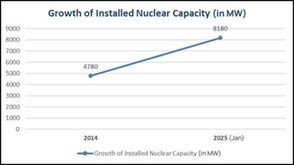A key highlight of the Union Budget 2025-26 is the launch of a Nuclear Energy Mission, which is focused on research and development (R&D) of Small Modular Reactors (SMRs).
About Nuclear Energy Mission
- The government has allocated ₹20,000 crore for this initiative, aiming to develop at least five indigenously designed and operational SMRs by 2033.
- To facilitate the implementation of the Nuclear Energy Mission, amendments to the Atomic Energy Act and Civil Liability for Nuclear Damage Act will be taken up by the parliament.
- These amendments are expected to encourage private sector investments in nuclear power projects. These legislative changes are expected to create a more conducive environment for investment and innovation in the nuclear sector.
- The mission aligns with India’s commitment to achieving 100 GW of nuclear energy capacity by 2047, a milestone deemed essential for reducing carbon emissions and meeting future energy demands. As of January 30, 2025, India’s nuclear capacity is 8180 MW.
- The government will enter into partnerships with the private sector with the motive of: Setting up Bharat Small Reactors, Research & development of Bharat Small Modular Reactor, and Research & development of newer technologies for nuclear energy.

Bharat Small Reactors (BSRs)
- The government is actively expanding its nuclear energy sector by developing Bharat Small Reactors (BSRs) and exploring partnerships with the private sector.
- BSRs are 220 MW Pressurized Heavy Water Reactors (PHWRs) with a proven safety and performance record.
- These reactors are being upgraded to reduce land requirements, making them suitable for deployment near industries such as steel, aluminium, and metals, serving as captive power plants to aid in decarbonization efforts.
- The plan involves private entities providing land, cooling water, and capital, while the Nuclear Power Corporation of India Limited (NPCIL) handles design, quality assurance, and operation and maintenance, all within the existing legal framework.
- This initiative aligns with India’s commitment to achieving 500 GW of non-fossil fuel-based energy generation by 2030 and meeting 50% of its energy requirements from renewable energy by 2030, as pledged at the COP26 Summit in Glasgow in 2021.
Small Modular Reactors (SMRs)
- In addition to BSRs, the Bhabha Atomic Research Centre (BARC) is developing Small Modular Reactors (SMRs) for repurposing retiring coal-based power plants and meeting power needs in remote locations.
- The Department of Atomic Energy (DAE) also plans to introduce new nuclear reactors, including high-temperature gas-cooled reactors for hydrogen co-generation and molten salt reactors aimed at utilizing India’s abundant thorium resources.
Small Modular Reactors (SMRs)
- India is actively exploring Small Modular Reactors (SMRs) as a crucial part of its energy transition strategy, aiming to achieve net-zero emissions while ensuring energy security.
- Small Modular Reactors (SMRs, are advanced nuclear reactors with a power generation capacity ranging from less than 30 MWe to 300+ MWe, provide a flexible, scalable, and cost-effective alternative to conventional large nuclear reactors.
- SMRs can play a transformative role in complementing renewable energy sources and stabilizing the grid.
- Their modular design allows for factory-based manufacturing, reducing construction timelines and costs, making them suitable for both on-grid and off-grid applications, including deployment in remote locations.
- India’s expertise in Pressurized Heavy Water Reactors (PHWRs) provides a strong foundation for the development and deployment of indigenous SMR designs.
- By integrating SMRs into its energy mix, India can address land constraints, reduce dependence on fossil fuels, and enhance its ability to meet international climate commitments under the Paris Agreement (2015) which India ratified in October 2016.
(Source: PIB)


